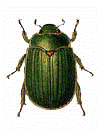Museum, University of Nebraska State
Document Type
Article
Date of this Version
1988
Abstract
The distinctive trace fossil Chubutolithes gaimanensis n. ichnosp. occurs in Casamayoran (early Eocene) and Colhuéhaupian (late Oligocene) alluvial rocks of the Sarmiento Formation in eastern Chubut Province, Argentina. Though known for nearly 70 years, its origin has remained obscure. Examination of new specimens and comparisons with modem analogs demonstrate that specimens of Chubutolithes represent the fossil nests of a mud-dauber (Hymenoptera: Sphecidae). Virtually identical nests are constructed today by mud-daubers in areas as disparate as southern Santa Cruz Province, Argentina, and Nebraska, confirming that quite similar trace fossils can be produced by several different taxa in a higher taxonomic clade. No satisfactory ethological term exists for trace fossils that, like Chubutolithes, were constructed by organisms above, rather than within, a substrate or medium. The new term aedificichnia is proposed.
Chubutolithes occurs in alluvial paleosols and is associated with a large terrestrial ichnofauna. These trace fossils include the nests of scarab beetles, compound nests of social insects, and burrows of earthworms.



Comments
Published in Journal of Paleontology 62(2), 1988, pp. 163-167.